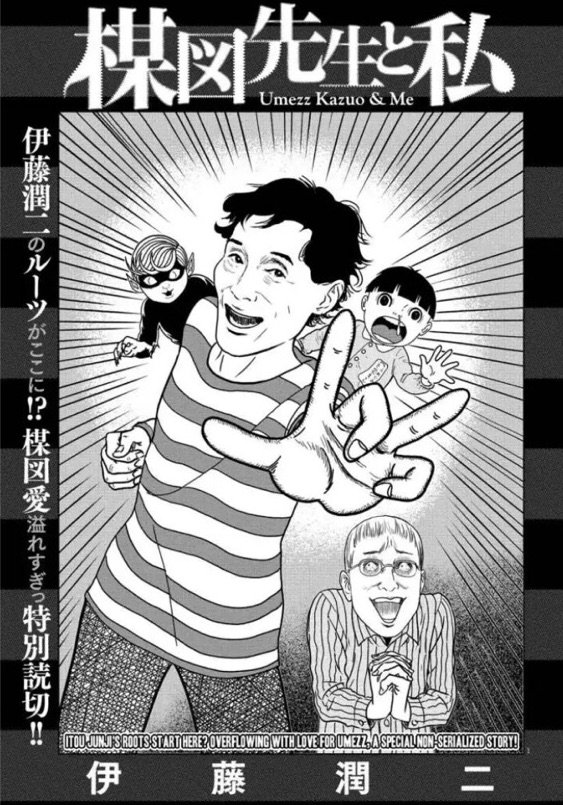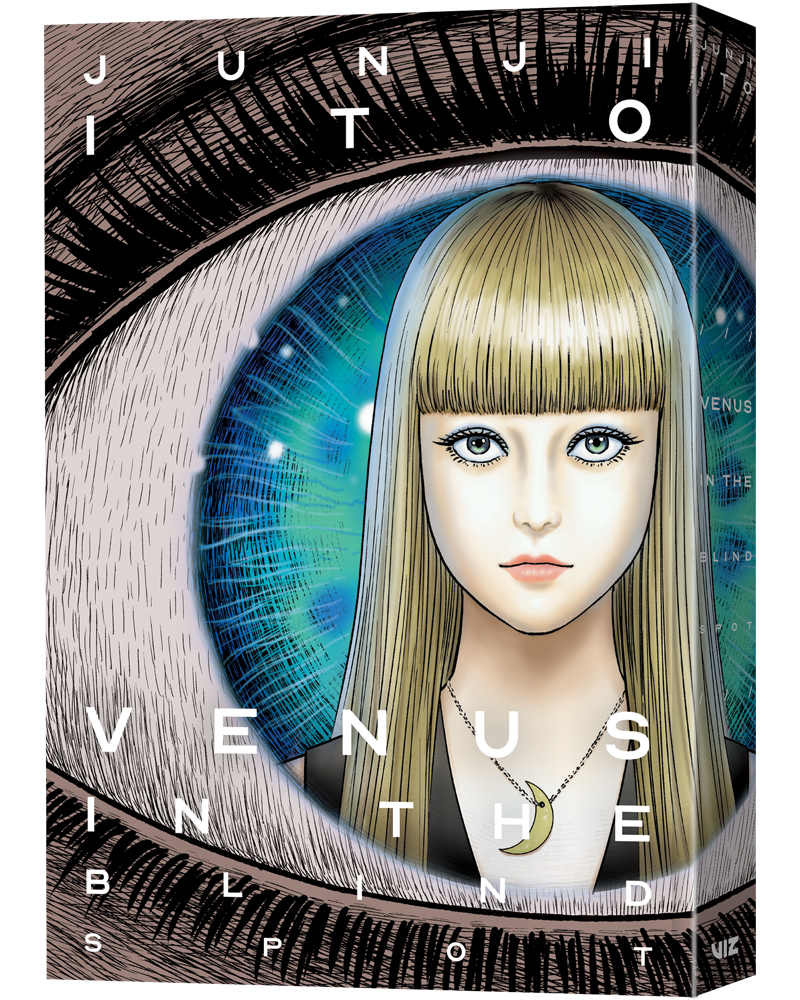Legendary horror mangaka Junji Ito is best known for acclaimed series such as Tomie, Uzumaki, and Gyo. However, his newest release, Venus In the Blind Spot, offers a collection of several short works from across the writer and illustrator’s renowned career. Ten stories are featured, including seven original pieces from Ito and three adaptations. I will continue by giving a short description and my personal rating of each story.
Billions Alone

The first story in the collection is perhaps the best, and easily the most disturbing. Michio is a young man who hasn’t left his bedroom since the 7th grade. After years of isolation, he is finally brought out of his room when an old love interest shows up at his door and encourages him to attend their class reunion. But meanwhile, a serial killer is on the loose targeting large groups and gatherings of people. The killer’s work is easily identifiable: they sew all their victims’ corpses together in large, grotesque displays. The threat of the killer begins to loom over the entire city, and gathering in groups of any size becomes too dangerous. Despite constant encouragement to “come together” by the mysterious Billions Alone Club, the majority of people choose to live in isolation like Michio. “Billions Alone” becomes eerily similar to today’s COVID landscape, replacing an invisible killer disease with a sadistic serial killer who goes unseen and leaves no trace of evidence behind.
Rating – 5/5
The Human Chair

The second tale is an adaptation of Japanese author Edogawa Ranpo’s classic short story of the same name. It tells the story of a woman haunted by a man living inside the chair in her home’s study. She is written off as delirious by her loveless husband, as it appears as though she is the only one to notice the man in the chair. “The Human Chair” is a discomforting, yet thought-provoking story of what it means to be loving and affectionate.
Rating – 4/5
An Unearthly Love
Another adaptation of one of Ranpo’s short stories; Kyoko falls in love with and eventually marries Kadono, who she finds very handsome but is rumored to be an emotionally cold man. Despite this, Kadono appears to show a deep adoration of Kyoko, almost to the point of embellishment. When he begins to sneak off and disappear into the storehouse in the middle of the night, Kyoko suspects that he may be having an affair with another woman—the one he considers his true love.
Rating – 3.5/5
Venus In the Blind Spot

The title story from the collection centers around a UFO enthusiasts club headed by Mariko. Mariko is the only girl in the club, and all the boys are madly in love with her. There’s just one problem: Mariko disappears before every one of their eyes whenever they get close to her. After finding scars on the back of their heads, the boys believe they were abducted and experimented on by aliens. This hysteria combined with their inability to see their “Venus” drives them insane, leading to the downfall of any who dare lay eyes on Mariko.
Rating – 4/5
The Licking Woman

The fifth story follows a community that is terrorized by a ghastly woman with a giant, venomous tongue who licks unsuspecting passersby. Miko, whose fiance and dog were killed by this Licking Woman, makes it her mission to track down and kill the monster before it claims more lives. She captures the woman with the help of a neighborhood watch, but she is merely sent to a psych ward after no proof is found linking her to any murder, and is released after several years. Upon her return, Miko aims to eliminate the Licking Woman to ensure she kills no others, but also for retribution. “The Licking Woman” is a unique monster story with a plethora of creepy, yet fun illustrations.
Rating – 5/5
Master Umezz and Me

“Master Umezz and Me” serves as something of an intermission between all the terrifying stories filling the collection. It is an autobiographical account of how Junji Ito became interested in horror manga as a boy through the works of Kazuo Umezo until he eventually begins to follow in his idol’s footsteps as an adult. Ito recounts how his two older sisters introduced him to Umezo through their love of horror manga, and how he quickly developed an obsession for the author and his writing. There are no real frightening moments in this story, but Ito depicts his boyhood self as gross and malformed at times in his illustrations. In fact, it is actually a relatively comical piece in Ito’s otherwise dark realm of imagination.
Rating – 4/5
How Love Came to Professor Kirida
An adaptation of “How Love Came to Professor Guildea”, the classic short story originally written by English writer Robert Hitchens. Professor Kirida is a celebrated writer who detests love in any way, form, or fashion. He decides to consult the opinion of a priest about a novel he is writing on Christianity. The two quickly begin discussing the role of love in the prosperity of mankind, and whether or not it is beneficial or detrimental. Despite his brilliance, Professor Kirida believes that his hatred for others has led to his success, and believes hate is what pushes humans into the future. Meanwhile, one of his writing students, Hayama, admires Kirida for his writing and seeks his approval and support to no avail. Hayama is withered by Kirida’s disdain for her and decides to take otherworldly measures to make love reach his soul.
Rating – 3.5/5
The Enigma of Amigara Fault

My personal favorite of the collection, this story centers around an unexplained phenomenon where holes shaped like human silhouettes appear on the side of a mountain. Many hike to see for themselves, but others arrive with the suspicion that there is a specific hole for them in the fault. Owaki is a young man who meets Yoshida, a young woman who believes she saw her silhouette in the fault during the news coverage. Owaki begins having foreboding nightmares about the holes, while Yoshido tries to keep her sanity after finding a hole she believes to be shaped like her. Before long people begin crawling into their “assigned” holes, fitting perfectly into the fault and never to be seen again. As pandemonium sweeps the mountainside, the allure of the Amigara Fault becomes stronger and stronger.
Rating – 5/5
The Sad Tale of the Principal Post
By far the shortest story in the collection at just four pages, it tells an odd and unwelcoming story of a family having dinner in their new house. After realizing their patriarch is missing, they begin hearing his cries for help from within the crawlspace. There they discover the grisly truth surrounding the principal support post holding up their grand new home.
Rating – 3/5
Keepsake
The final story begins with the discovery of a crying baby in the grave of a woman who died while pregnant. It is decided that the baby belongs to the woman’s widower, Toyoji, who has since remarried and had another child with his mistress, O-Mitsu. The mistress disapproves but must take the child into their home for the sake of appearances. The boy, named Manjuro, grows up to become sickly and deformed and scares the other children while they play, becoming an outcast. He is also hated with a severe passion by O-Mistu, who constantly berates him and ties him to a post. Soon Manjuro’s true origins are revealed, and O-Mitsu must face the consequences of her inglorious decisions.
Rating – 4/5
Conclusion
Venus In the Blind Spot has several standout moments, and even the comparatively lackluster entries are still compelling. The collection in its entirety is a superb showcase for Ito’s talents as not merely a storyteller, but as a writer who can conjure tense, nerve-racking, and sometimes downright unsettling scenes that are brought to life by his intricate illustrations.











